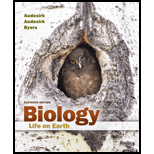
Concept explainers
Which of the following is not true of a single
a. It is usually caused by a translocation mutation.
b. It is usually caused by a nucleotide substitution mutation.
c. It may change the
d. It is inherited from parent to offspring.
Introduction:
Single nucleotide polymorphisms (SNPs) are a type of mutation in which one nucleotide at a particular position on deoxyribonucleic acid (DNA) is replaced by another nucleotide. SNPs are responsible for a number of genetic disorders in humans.
Answer to Problem 1MC
Correct answer:
SNPs cannot be caused by a translocation mutation.
Explanation of Solution
Justification/Explanation for the correct answer:
SNPs are caused by the replacement of one nucleotide at a particular position on the DNA by another nucleotide. Translocation refers to the rearrangement of segments of chromosomes, meaning that a particular segment of a chromosome breaks off from its location and reattaches at a new location. Option (a) is given that SNPs are usually caused by translocation mutations is a false statement. Hence, option (a) is correct.
Explanation for the incorrect answer:
Option (b) is given that SNPs are caused by nucleotide substitution mutations is a false statement. SNPs are caused by the substitution or replacement of a particular nucleotide at a given position with a different nucleotide. So, it is an incorrect option.
Option (c) is given that SNPs may change the phenotype of an organism is a false statement. SNPs can be of two types: synonymous and nonsynonymous. In a synonymous SNP, the amino acid coded by the triplet is not changed and the same protein is made. In a nonsynonymous SNP, the amino acid encoded by the triplet changes and an altered protein is made. This altered protein would give a different phenotype to the affected individual. So, it is an incorrect option.
Option (d) is given that SNPs are inherited from parent to offspring is a false statement. SNPs are changes in the DNA. Any change in the DNA of the parent will be passed on to his/her offspring because DNA is the basis of inheritance. So, it is an incorrect option.
Hence, options (b), (c), and (d) are incorrect.
Therefore, it can be concluded that SNPs are substitutions of a single nucleotide at a particular position by another nucleotide. They are passed on from the parent to the offspring and may alter the phenotype of the individual.
Want to see more full solutions like this?
Chapter 14 Solutions
Biology: Life on Earth (11th Edition)
- What is the opening indicated by the pointer? (leaf x.s.) stomate guard cell lenticel intercellular space none of thesearrow_forwardIdentify the indicated tissue? (stem x.s.) parenchyma collenchyma sclerenchyma ○ xylem ○ phloem none of thesearrow_forwardWhere did this structure originate from? (Salix branch root) epidermis cortex endodermis pericycle vascular cylinderarrow_forward
- Identify the indicated tissue. (Tilia stem x.s.) parenchyma collenchyma sclerenchyma xylem phloem none of thesearrow_forwardIdentify the indicated structure. (Cucurbita stem l.s.) pit lenticel stomate tendril none of thesearrow_forwardIdentify the specific cell? (Zebrina leaf peel) vessel element sieve element companion cell tracheid guard cell subsidiary cell none of thesearrow_forward
- What type of cells flank the opening on either side? (leaf x.s.) vessel elements sieve elements companion cells tracheids guard cells none of thesearrow_forwardWhat specific cell is indicated. (Cucurbita stem I.s.) vessel element sieve element O companion cell tracheid guard cell none of thesearrow_forwardWhat specific cell is indicated? (Aristolochia stem x.s.) vessel element sieve element ○ companion cell O O O O O tracheid O guard cell none of thesearrow_forward
- Identify the tissue. parenchyma collenchyma sclerenchyma ○ xylem O phloem O none of thesearrow_forwardPlease answer q3arrow_forwardRespond to the following in a minimum of 175 words: How might CRISPR-Cas 9 be used in research or, eventually, therapeutically in patients? What are some potential ethical issues associated with using this technology? Do the advantages of using this technology outweigh the disadvantages (or vice versa)? Explain your position.arrow_forward
 Human Heredity: Principles and Issues (MindTap Co...BiologyISBN:9781305251052Author:Michael CummingsPublisher:Cengage Learning
Human Heredity: Principles and Issues (MindTap Co...BiologyISBN:9781305251052Author:Michael CummingsPublisher:Cengage Learning Biology (MindTap Course List)BiologyISBN:9781337392938Author:Eldra Solomon, Charles Martin, Diana W. Martin, Linda R. BergPublisher:Cengage Learning
Biology (MindTap Course List)BiologyISBN:9781337392938Author:Eldra Solomon, Charles Martin, Diana W. Martin, Linda R. BergPublisher:Cengage Learning Concepts of BiologyBiologyISBN:9781938168116Author:Samantha Fowler, Rebecca Roush, James WisePublisher:OpenStax College
Concepts of BiologyBiologyISBN:9781938168116Author:Samantha Fowler, Rebecca Roush, James WisePublisher:OpenStax College





